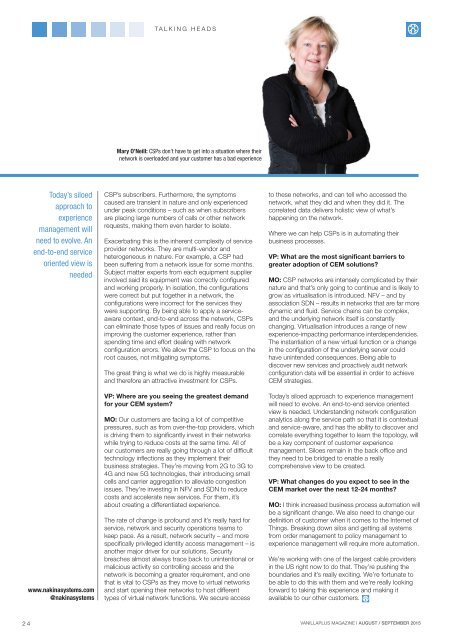CEM
1UBylUS
1UBylUS
Create successful ePaper yourself
Turn your PDF publications into a flip-book with our unique Google optimized e-Paper software.
TALKING HEADS<br />
Mary O’Neill: CSPs don’t have to get into a situation where their<br />
network is overloaded and your customer has a bad experience<br />
Today’s siloed<br />
approach to<br />
experience<br />
management will<br />
need to evolve. An<br />
end-to-end service<br />
oriented view is<br />
needed<br />
www.nakinasystems.com<br />
@nakinasystems<br />
CSP’s subscribers. Furthermore, the symptoms<br />
caused are transient in nature and only experienced<br />
under peak conditions – such as when subscribers<br />
are placing large numbers of calls or other network<br />
requests, making them even harder to isolate.<br />
Exacerbating this is the inherent complexity of service<br />
provider networks. They are multi-vendor and<br />
heterogeneous in nature. For example, a CSP had<br />
been suffering from a network issue for some months.<br />
Subject matter experts from each equipment supplier<br />
involved said its equipment was correctly configured<br />
and working properly. In isolation, the configurations<br />
were correct but put together in a network, the<br />
configurations were incorrect for the services they<br />
were supporting. By being able to apply a serviceaware<br />
context, end-to-end across the network, CSPs<br />
can eliminate those types of issues and really focus on<br />
improving the customer experience, rather than<br />
spending time and effort dealing with network<br />
configuration errors. We allow the CSP to focus on the<br />
root causes, not mitigating symptoms.<br />
The great thing is what we do is highly measurable<br />
and therefore an attractive investment for CSPs.<br />
VP: Where are you seeing the greatest demand<br />
for your <strong>CEM</strong> system?<br />
MO: Our customers are facing a lot of competitive<br />
pressures, such as from over-the-top providers, which<br />
is driving them to significantly invest in their networks<br />
while trying to reduce costs at the same time. All of<br />
our customers are really going through a lot of difficult<br />
technology inflections as they implement their<br />
business strategies. They’re moving from 2G to 3G to<br />
4G and new 5G technologies, their introducing small<br />
cells and carrier aggregation to alleviate congestion<br />
issues. They’re investing in NFV and SDN to reduce<br />
costs and accelerate new services. For them, it’s<br />
about creating a differentiated experience.<br />
The rate of change is profound and it’s really hard for<br />
service, network and security operations teams to<br />
keep pace. As a result, network security – and more<br />
specifically privileged identity access management – is<br />
another major driver for our solutions. Security<br />
breaches almost always trace back to unintentional or<br />
malicious activity so controlling access and the<br />
network is becoming a greater requirement, and one<br />
that is vital to CSPs as they move to virtual networks<br />
and start opening their networks to host different<br />
types of virtual network functions. We secure access<br />
to these networks, and can tell who accessed the<br />
network, what they did and when they did it. The<br />
correlated data delivers holistic view of what’s<br />
happening on the network.<br />
Where we can help CSPs is in automating their<br />
business processes.<br />
VP: What are the most significant barriers to<br />
greater adoption of <strong>CEM</strong> solutions?<br />
MO: CSP networks are intensely complicated by their<br />
nature and that’s only going to continue and is likely to<br />
grow as virtualisation is introduced. NFV – and by<br />
association SDN – results in networks that are far more<br />
dynamic and fluid. Service chains can be complex,<br />
and the underlying network itself is constantly<br />
changing. Virtualisation introduces a range of new<br />
experience-impacting performance interdependencies.<br />
The instantiation of a new virtual function or a change<br />
in the configuration of the underlying server could<br />
have unintended consequences. Being able to<br />
discover new services and proactively audit network<br />
configuration data will be essential in order to achieve<br />
<strong>CEM</strong> strategies.<br />
Today’s siloed approach to experience management<br />
will need to evolve. An end-to-end service oriented<br />
view is needed. Understanding network configuration<br />
analytics along the service path so that it is contextual<br />
and service-aware, and has the ability to discover and<br />
correlate everything together to learn the topology, will<br />
be a key component of customer experience<br />
management. Siloes remain in the back office and<br />
they need to be bridged to enable a really<br />
comprehensive view to be created.<br />
VP: What changes do you expect to see in the<br />
<strong>CEM</strong> market over the next 12-24 months?<br />
MO: I think increased business process automation will<br />
be a significant change. We also need to change our<br />
definition of customer when it comes to the Internet of<br />
Things. Breaking down silos and getting all systems<br />
from order management to policy management to<br />
experience management will require more automation.<br />
We’re working with one of the largest cable providers<br />
in the US right now to do that. They’re pushing the<br />
boundaries and it’s really exciting. We’re fortunate to<br />
be able to do this with them and we’re really looking<br />
forward to taking this experience and making it<br />
available to our other customers.<br />
24 VANILLAPLUS MAGAZINE I AUGUST / SEPTEMBER 2015


